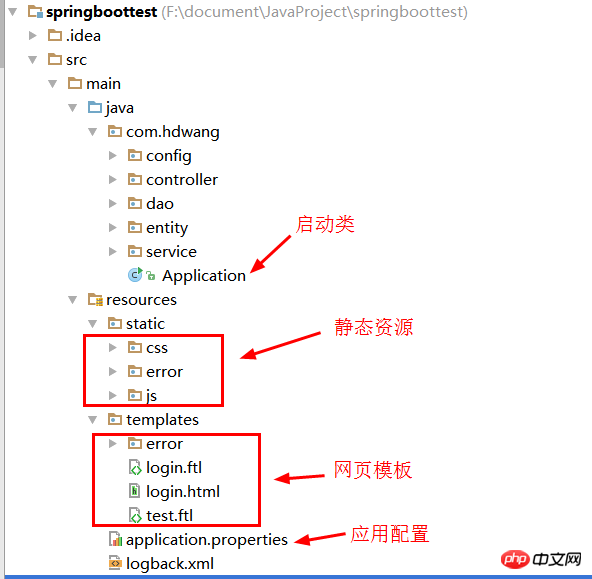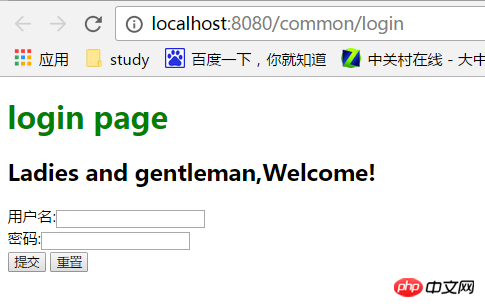
Dieser Artikel stellt hauptsächlich die relevanten Informationen für den Einstieg in Spring Boot (Web+Freemarker) vor.
1 Konfigurieren Sie die Maven-Datei pom.xml
<?xml version="1.0" encoding="UTF-8"?>
<project xmlns="http://maven.apache.org/POM/4.0.0"
xmlns:xsi="http://www.w3.org/2001/XMLSchema-instance"
xsi:schemaLocation="http://maven.apache.org/POM/4.0.0 http://maven.apache.org/xsd/maven-4.0.0.xsd">
<modelVersion>4.0.0</modelVersion>
<groupId>com.hdwang</groupId>
<artifactId>spring-boot-test</artifactId>
<version>1.0-SNAPSHOT</version>
<name>spring-boot-test</name>
<description>project for test Spring Boot</description>
<properties>
<project.build.sourceEncoding>UTF-8</project.build.sourceEncoding>
<java.version>1.8</java.version>
</properties>
<!-- Inherit defaults from Spring Boot -->
<parent>
<groupId>org.springframework.boot</groupId>
<artifactId>spring-boot-starter-parent</artifactId>
<version>1.5.4.RELEASE</version>
<relativePath/>
</parent>
<dependencies>
<!-- Add typical dependencies for a web application -->
<dependency>
<groupId>org.springframework.boot</groupId>
<artifactId>spring-boot-starter-web</artifactId>
</dependency>
<dependency>
<groupId>org.springframework.boot</groupId>
<artifactId>spring-boot-starter-freemarker</artifactId>
</dependency>
<!-- auto redeploy -->
<dependency>
<groupId>org.springframework.boot</groupId>
<artifactId>spring-boot-devtools</artifactId>
<optional>true</optional>
</dependency>
<!-- Package as an executable jar -->
<build>
<plugins>
<plugin>
<groupId>org.springframework.boot</groupId>
<artifactId>spring-boot-maven-plugin</artifactId>
</plugin>
</plugins>
</build>
</project>2. Dateistruktur (statisch/templates/application.properties/logback.xml) Namen sind vereinbart, nur bestimmte Mehrere Namen, Weitere Informationen finden Sie in der offiziellen Spring Boot-Dokumentation. Der folgende Name ist eine der Konfigurationsmethoden)

3. Erstellen Sie eine Startup-Klasse (platziert auf der obersten Ebene, sub -Layer (Ordner der unteren Ebene) kann gescannt und injiziert werden)
@SpringBootApplication
public class Application {
/**
* main function
* @param args params
*/
public static void main(String[] args){
SpringApplication.run(Application.class,args);
}
}4. Erstellen Sie einen Controller (im unteren Verzeichnis der Anwendungsklasse)
@Controller
@RequestMapping("/common")
public class Common {
@Value("${msg:Welcome!}")
private String msg;
/**
* get a page
* @return a page with name called return value
*/
@RequestMapping("login")
public String getLoginPage(ModelMap map){
map.put("welcomeMsg",this.msg);
return "login";
}
}5 eine Webseitenvorlage login.ftl (Freemarker muss das Suffix ftl verwenden, und ich habe mich schon lange davon täuschen lassen! js/css usw. werden in den entsprechenden Ordnern abgelegt. Beachten Sie, dass /static nicht im Zugriff enthalten ist Pfad. Davon habe ich mich auch schon lange täuschen lassen!)
<!DOCTYPE html>
<html>
<head>
<meta charset="UTF-8" />
<title>login</title>
<link href="/css/home.css" rel="external nofollow" rel="stylesheet" type="text/css" />
<script type="text/javascript" src="/js/jquery-2.0.3.min.js"></script>
<script type="text/javascript" src="/js/home.js"></script>
</head>
<body>
<h1>login page</h1>
<h2>${welcomeMsg}</h2>
<form>
<p>
<label>用户名:<input type="text" id="username"/></label>
</p>
<p>
<label>密码:<input type="password"/></label>
</p>
<p>
<input type="submit" value="提交"/>
<input type="reset" value="重置" />
</p>
</form>
</body>
</html>6. Übernehmen Sie die Konfigurationsdatei schreiben Sie
und erstellen Sie eine neue application.properties-Datei und fügen Sie den folgenden Inhalt hinzu
msg=Ladies and gentleman,Welcome!
7. Starten Sie den Browser
und führen Sie ihn aus. Besuchen Sie: http://localhost:8080/common/login

8. Bereitstellung
mvn-Paket Paket
java -jar xxx.jar Führen Sie einfach dieses Paket aus
Das obige ist der detaillierte Inhalt vonDetaillierte Erläuterung der Spring Boot-Einführung in JAVA (Web + Freemarker). Für weitere Informationen folgen Sie bitte anderen verwandten Artikeln auf der PHP chinesischen Website!
 So laden Sie die heutigen Schlagzeilenvideos herunter und speichern sie
So laden Sie die heutigen Schlagzeilenvideos herunter und speichern sie
 Der Unterschied zwischen Windows-Ruhezustand und Ruhezustand
Der Unterschied zwischen Windows-Ruhezustand und Ruhezustand
 So lösen Sie eine Java-Ausnahme beim Lesen großer Dateien
So lösen Sie eine Java-Ausnahme beim Lesen großer Dateien
 Was ist Löwenzahn?
Was ist Löwenzahn?
 Was sind die Vorteile des Java-Factory-Musters?
Was sind die Vorteile des Java-Factory-Musters?
 Was bedeutet Linux?
Was bedeutet Linux?
 Einführung in SSL-Erkennungstools
Einführung in SSL-Erkennungstools
 Welche Datensicherungssoftware gibt es?
Welche Datensicherungssoftware gibt es?
 So entsperren Sie Android-Berechtigungsbeschränkungen
So entsperren Sie Android-Berechtigungsbeschränkungen




